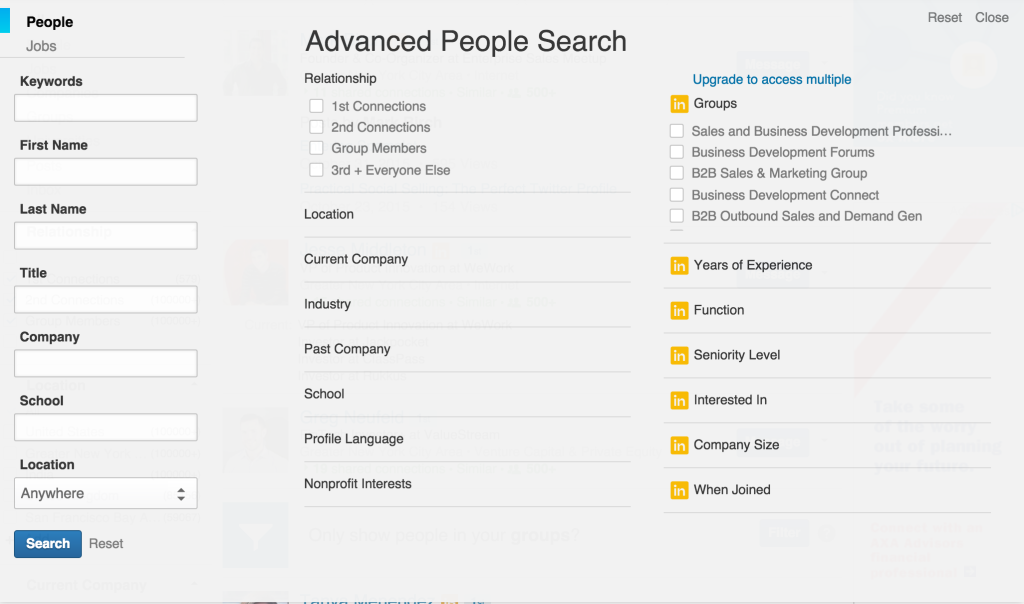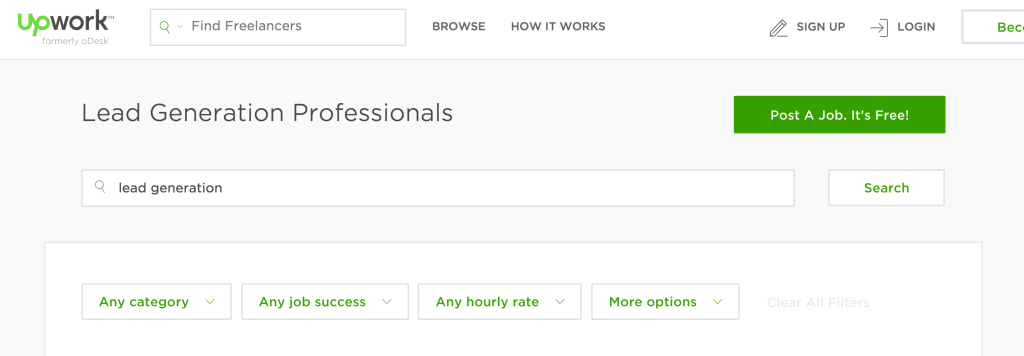Software products have it good … If you do a quick search for software launch strategies, you’ll find tried and true methods for building massively scalable sales from the get-go. There are all sorts of hacks and high-tech shortcuts to building a marketing machine that starts at full speed and sustains itself.

Source: StellarRegions.com
But your company might not have this privilege. Maybe you don’t possess the data, email list, or flexible purchase methods to make automation a no-brainer. If you’re with a service or commodity business, chances are you didn’t make your bones by growth hacking. You probably started with a trickle of customers originating from word-of-mouth referrals.
Referrals: natural start, eventual dead end
Individual referrals are a great way to feed your company in its early days. Driving referrals throughout your sales process is a must for recurring business, and you’d be crazy not to ask for intros throughout each and every engagement.
Relying on referrals alone, however, leads to stagnation and unpredictable results. I know many salespeople and entrepreneurs behind boutique marketing agencies, IT service firms, design shops, consultancies, and other service and commodity businesses. Their moods are unpredictable: They get a promising referral one day, and they’re on top of the world, then they hit a slowdown and they’re down in the dumps.
Although volatility is unavoidable, if you don’t go with the methods that will allow you to understand the reasons behind fluctuations, and take action to correct course, then you’re stuck with guesswork, uncertainty, and stress. As Peter Drucker said, “What gets measured gets managed,” and it’s pretty difficult to measure the rate at which your buddy will send you leads.
So how do you build the growth and consistency that can only happen by going beyond your personal network and previous customers? How do you transition from word-of-mouth to automation?
How we automated
I was the first employee at IdeaRocket, which would become the premier studio for high quality explainer videos. Our beginnings, however, were humble. The company was born from a single freelancer, our founder Will Gadea, doing random projects that came to him from people in his network. Eventually he honed in on the explainer niche, and built up enough work to leave his day job.
Instead of relying on boom-and-bust referrals, Will, who had a background with Excel and analytics, went full throttle into Google Adwords. He learned from Brad Geddes’ manual, input relevant keywords, and started the long journey of trial and error that continues to this day. Before long he was able to hire me to handle sales and BD, which meant closing more of the leads he was efficiently generating. We would go on to win 16 Fortune 500 clients and do over $1.4 million in sales. Now I work with IdeaRocket as a consultant, and we buttress our SEM with tons of content, tradeshows, targeted email campaigns, and other strategies.
Adwords has its pros and cons, which we’ll cover, but it served as our jumping off point because it resonated with its practitioner. Furthermore, Will and I have enjoyed the SEM learning process and the leeway it offers for easily testing ideas.
Your initial automation methods will depend on your skills and affinities.
You don’t have to do everything
Many marketing and sales gurus tell you to do it all. Video? Imperative. Blogging? Never stop writing. Networking? Schmooze until your vocal chords give out. Podcasting and Periscope? Launch a show or be left to die in the desert of failure! I’m exaggerating, but you get the idea.
Sure, diversification is important. That said, there are usually one or two channels that will come out stronger than the rest. This is classic 80/20 stuff. For IdeaRocket, it was Adwords. What will your methods be? Let’s cover some ideas.
Step 1: Pick an outbound and inbound strategy
If you’re expanding out from a referral model, you probably don’t have all the time in the world. Maybe you run a business and you’re constantly jumping back and forth between customer service, admin, and sales. Or you could be a salesperson who rarely gets a glimpse at the marketing side of the fence.
Regardless, pick one or two strategies that fit your situation and gel with your skills. Ideally you want to push for short term results with outbound methods, and long term with inbound.
This isn’t every strategy under the sun, nor are the instructions complete, but these will inspire ideas and get you to the starting line. Go for one or two that get your juices flowing. Do less better instead of doing more worse.
Outbound
Direct email
This is the tried-est, truest, low-hanging-fruitiest thing on the list, especially for newer businesses. The money investment is almost nothing. There are direct email approaches galore, but in a nutshell you’re finding your buyers, usually via LinkedIn, doing a bit of email research, and sending a short and compelling message. Just stay away from LinkedIn’s InMails because no one reads them. You can go further by adding a face to a name with the help of Twitter, and following those you’re going after before sending anything.
My direct email method
I start in LinkedIn’s Advanced Search, casting a wide net by plugging in 50+ relevant companies, and entering one or two job titles. I peruse a couple profiles and find keywords related to my niche (explainer videos), such as “multimedia” and “video marketing”, and I plug those into the “Keyword” area. I continue this process, expanding the net by adding companies and shrinking it by adding keywords and titles, until I have strong list of 50-100 prospects. Next, I find emails via this method or a research service. Finally, I send my targets short messages, similar to the samples here. I track my emails with YesWare (though I may switch to SideKick soon), so I can execute the next strategy …

Advanced cold calling
Cold calling is not dead, but it changed. There’s no reason to interrupt the life of a stranger and try to talk your way up to a decision maker. This is an aggravating waste of time for all involved parties. There’s a better way.
Since you are tracking your direct emails, you’ll know when your messages are opened and links are clicked. You might include a link to helpful content, like an ebook, or a tool, like an ROI calculator spreadsheet. When an event like an open or click happens, it’s the most relevant time to be in front of your prospect, and it’s when you should pick up the phone.
Winning on your cold calls is more than I can cover here, but a great starting place is Aaron Ross and Marylou Tyler’s Predictable Revenue, which suggests planning each conversation by first defining The 3 A’s:
- What Answers do you want to learn in the call?
- What Attitudes do you wish the prospect to feel?
- What Actions should occur after the call?
Targeted email blasts
List purchasing has gotten a bad wrap, but there are plenty of companies killing it with this approach. Data.com is an ideal starting point, especially if you’re already using SalesForce, because it will let you get super–targeted. Just make sure to keep your messaging short and conversational. One successful strategy is aiming for senior people and getting referred down to your ideal prospect.
Tradeshows and conferences
After attending a number of tradeshows, I have to admit, I used to be skeptical of the benefits. The experience reminded me of being at some college party with thirty dudes and four ladies. After learning from friends and experts, I now know that there’s a profitable approach to selling in situations where everyone is hustling.
Tradeshow champions frequently generate hundreds of qualified leads at each turnout. They win by budgeting their time, setting the right goals for hectic three-minute conversations, and following up in a diligent and organized way. Check out Scott Britton’s guide here.
Inbound
SEM
Let’s start with the pros: Search Engine Marketing, usually by way of Google Adwords pay-per-click ads, is arguably the most direct way to get high-value traffic to your site. All the data and results of your investment is right in front of you. You’ll know exactly how much you’re paying for a conversion and an acquisition.
The cons: It’s expensive and it can take a long time to get enough data to understand what keywords to target, and how to target them. There’s a relatively steep learning curve that’s often taken for granted.
If you’re skilled with analytics and you have some money to play with, then this might be the right place to focus your energy from the get-go. If that’s not you, you can still dip your toe in the water by going for long-tail keywords and limiting your budget. Adwords can be a better late-game strategy because as you build up your site’s strength and ability to convert, your Google Quality Score increases, which means you pay less at the ad placement “auction.”
Blogging and SEO
As Google’s search algorithm reaches Ex-Machina proportions, there are fewer ranking tricks and hacks. It’s all about churning out content that resonates.
The big question: Are you the right one to do the writing? If you make plans to write three articles per month, will you stay the course in the face of mission–critical sales meetings, customer service fires, admin tasks, and other interruptions? Probably not.
Unless your background and business model are based on content (like mine), relying on an outsourced writer makes a lot of sense. Look to Upwork, or consider hiring a dedicated journalist. Create a regular process for getting the blog topics from your brain onto their blank page.
Guest posting
After you’ve built a foundation of helpful information and/or interesting posts on your site, there’s a point of diminishing returns when it comes to publishing more content. This is when you want to expose yourself to new audiences.
To launch an effective guest blogging campaign, bring on a writer with a background doing research and cold outreach to help you secure placements. Go for sites where there’s a barrier to entry, but don’t fight a losing battle by trying to convince someone who never features guests to allow yours. Consider linking back to a squeeze page where you offer something useful in exchange for email addresses. Here’s a starting guide from Neil Patel.
List building and email automation
If you’re lucky, your audience will read your site around once a week. Their inboxes? They check those multiple times per day, and that’s where you want to be. Building your email list takes time, and it’s never too early to get started. While the rest of the strategies are pick-and-choose, this one is mandatory!
You can offer ebooks and other goodies to entice sign-ups. When you write your drip campaigns, pretend like you’re reaching out to a friend, talking over a cool new strategy or hack you just discovered. Go with mostly text to make your messages look natural. Keep your subject lines conversational, especially when it comes to capitalization (i.e., go with “How to automate sales,” NOT “5 Incredible Strategies for Automating Sales”).
There are different email patterns for driving leads and sales. Though the specific approaches vary, the main point is to balance out your sales pitches with tons of useful information.
Social media
Hubspot’s Mark Roberge, in The Sales Acceleration Formula, compares social media to fitness. To paraphrase: it has to be frequent, results are rarely short term, and no one else can do it for you.
I find social media extremely distracting and daunting, but I recognize its aggregate value. My solution? Buffer. I schedule all my messaging for the month at once, and I post stuff in real time when I’m inspired.
Affiliates, joint ventures, and partners
This and the next strategy are later plays. The best partners are those who feel confident about your offering, and that usually requires you to have at least a few major customers under your belt.
If you sell a highly-transactional digital product, you might go with a streamlined affiliate network like Clickbank or JVZoo. If your product has an involved sales cycle, it’s all about relationships.
Is there a high-end provider who can cover her cost of acquisition by sending you leads in return for a commission? Or maybe you can go for symbiosis. At IdeaRocket, I often seek out small agencies and live action production houses to funnel us leads for animation projects. Conversely, I send these shops the leads who are looking for marketing help or live action video services.
Webinars
Staging a major online event with a group of potential buyers, one that can be infinitely large, is a golden strategy. Webinar conquerors offer tons of useful information, they engage their audience, and they make extremely persuasive limited time offers. Successful webinars have made millions. Best of all, they can be automated with platforms like Stealth Seminar.
The big prereq, however, is a pretty expansive email list. Although there are a few crazy newbie success stories, most webinar winners have a major following to whom they can promote the event.
Podcasting
For whatever reason, audio builds intimacy. Listeners become devoted to hosts and their guests in a way that rarely happens in the blogosphere or on YouTube. When I hosted a college radio show, we received bizarre letters from insane people, as well as late night calls from prison inmates. But that’s a story for another time!

Me on KZSC
Podcasting is bigger than the sum of its parts. In addition to the marketing benefits, it compels hosts to build relationships with thought leaders in their fields.
Before you jump into podcasting, make sure it’s something you’re ready to maintain. While lagging with blog posts isn’t always a deal breaker, successful podcasts tend to publish frequently, or else they lose footing.
Step 2: Make time
When you get inspired by new ideas, it’s easy to pile them on top of everything else. We all put new undertakings on our plates without clearing room for them. As a result, stuff gets dropped.
Be realistic about your time, and choose your sales automation methods accordingly. From there, cut out the time wasters, even if if they seem important at first glance. This means being a little more critical about your everyday tasks. Instead of going to that repetitive networking event, considering spending those two hours building a target list for your direct email campaign.
Step 3: Research
Articles, books, and online courses are helpful, and there’s no reason not to take stock of these easily accessible resources. Unfortunately, many gurus play up their successes with a particular strategy, and downplay their failures. Also, many resources fail to offer the context needed for you to set reasonable expectations based on your unique situation.
Conversations with real people offer the most helpful insight. It’s best to connect with those in your network who have first-hand experience with the strategy you’re considering. Also, don’t be afraid to drop a few bucks on Clarity. Speaking with an expert for an hour might save you tons of time and money in the long run.

Step 4: Get off and running
Now that you delved into a few methods that gel with your business, skills, and interests, it’s time to start implementing them.
The key to follow-through: Deadlines and KPIs
This is huge. Make your deadlines ambitious but realistic. Make your Key Performance Indicators easily monitorable. An ideal KPI for a guest post might be email signups, but not necessarily sales leads. On the other hand, a direct email campaign should be tied directly to metrics like those.
Use a CRM you can rely on for bridging the gap between your marketing efforts and lead generation. Hubspot offers an excellent free platform.
For task management, use whatever platform works for you (I like Glip); just make sure it’s all or nothing. Treat it as your external brain. If your system becomes a leaky bucket, you’ll lose faith in it, and you won’t use it.
Setting expectations
Moving from word-of-mouth to a predominantly automated sales model won’t happen overnight. As humans, we tend to overestimate our short term gains and underestimate our long term potential. We’re kind of stupid in an interesting way!
The important thing is to ensure that you’re balancing your resources between immediate outbound gains and eventual inbound prosperity. Eventually, you want the latter to overtake the former.
As an aside, don’t get too caught up with the metrics at first. Squinting at Google Analytics isn’t very valuable until you have enough data (i.e., traffic) to paint a revealing picture. For similar reasons, there’s limited benefit to perfectly tweaking your website when you’re still building a following. It’s better to use that time to get yourself in front of new audiences.
Step 5: Automate further
Once your new strategies are in full swing and starting to produce results, consider how you can reduce the resources you’re putting toward them. As for those few hours a week you’re devoting to LinkedIn research, a lead generation virtual assistant can take that over. That podcast you’re transcribing by hand for use in a blog post, you can outsource that quickly for little money.

Admittedly, delegating examples like these is a no-brainer, but it gets tougher when it comes to tasks with many moving parts. Automation is a muscle you have to strengthen by exercising it. This comes from thinking creatively to get tasks off your plate, bringing on help, and leveraging new tools and technology.
Final words
The bad news: As more and more companies get the memo about automation, the word-of-mouth model will become increasingly less promising. Finding a vetted solution from a two-second Google search, or from a rec by a trusted podcast host, is simply too convenient.
The good news: There are many proven automation methods, and resources for ensuring they produce results. Just pick the ones that work for you.
Are you transitioning from a word-of-mouth model? Let us know how it’s going!








